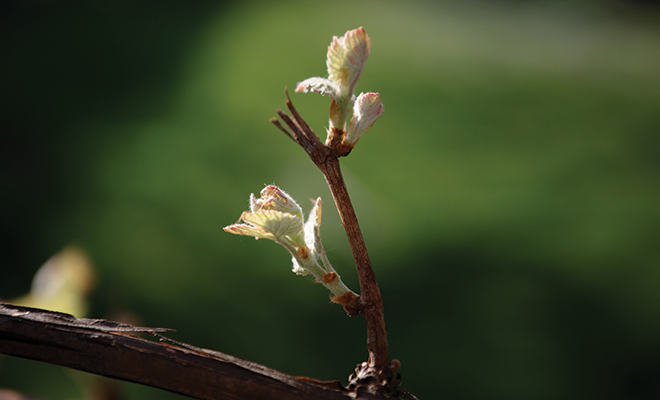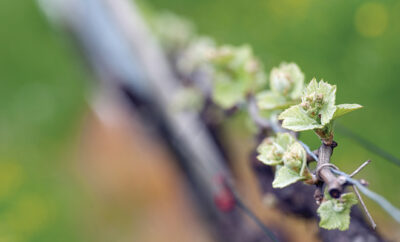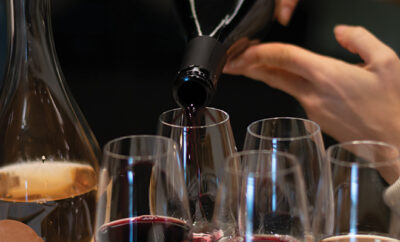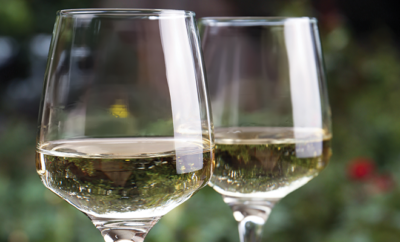
Buds in the Vineyard!
April showers bring May flowers, or so we’ve all learned over time. This May, however, will prove to be a most interesting time for agricultural products such as honey, tomatoes and wine.
The fates of wine country and farm country intertwine when so much of the weather and soil conditions have an immense impact on both. We have all heard of “good years” and “bad years” referenced in wine ratings and conversations. Whether it’s drought conditions, record-breaking rain storms or recurring snow and ice storms, the flowers of May will be the topic of conversation at nearly every aisle in the grocery store.
This year especially, many of America’s wine regions have experienced quite a bit of water. Others have experienced either unseasonable warm or unseasonably cold temperatures. Whether it was steady rainfall, snow, freezing rain or flood waters, we will see some interesting results in the 2017 vintages. We eagerly await the effects of this year’s increased water on the vineyards and promise to visit this topic again after this year’s harvest.
Bud break is the signal to many of us that all is well in our wine-farms. Wine grape viticulture and enology rely upon constant measurement of vineyard soils, water, fruit acidity, cluster density and vine health, among many other vital observations. We eagerly watch the grapevines grow, winding their way along the leads before bearing fruit. I’ll pass through the rows of the vineyards daily, just enjoying the peaceful nature of the environment, only to discover that, lo and behold, a tiny little vine shoot has emerged from the bud and is reaching for sunlight, making it available for all the local bees and other elements that create amazing wine grapes.
Bud break, then, signals the end of dormancy after the winter. The wine grape’s annual cycle is determined by the age and health of the vine as well as the climate in which the grape is grown. As the temperature rises and the amount of sunlight reaching the vine increases, usually in March or April in the northern hemisphere, the vine is teased out of its natural sleep cycle. Hormones activate, water, organic acids and minerals rise up the stems and sap begins to flow. But the new buds could still face some difficulty, such as a late frost, and so the growers continuously monitor weather conditions and prepare themselves to respond.
Keeping the wine grape crop safe this year required some planning way before the seasonal weather patterns occurred. Farmed fruit such as strawberries, tomatoes and lettuce grow right in the ground, while recently planted young wine grape vines have been planted with the future in mind. Supporting the growing vines in a way that enables more sunlight to reach more grape clusters increases the overall harvest, which increases the quantity of wine-making fruit. Utilizing modernized harvest and pruning techniques also helps the vines learn and evolve over four to six years to reach their fullest potential naturally, as the wine grape grower directs each row’s growth. As the vines mature, they make their way along the wires of the trellises to their destiny of providing beautiful clusters of sauvignon blanc, zinfandel, pinot noir and others.
Trellises have been used for farming climbing vegetables for hundreds of years. This method maximizes acreage, hydration and nutrition to benefit the entire crop, also making it easier for harvesting. With wine grapes, some farmers strive to encourage the young vines toward upward growth using wires, rather than downward growth, where gravity may pull down the vines, limiting sunlight.
It’s also interesting that the agricultural sciences apply to wine and beer alike. Beer producers are as watchful of the 2017 vintage as anyone. Hops, used to make beer, is also an agricultural crop producing new-found excitement in craft beers. A twining perennial vine grown on farms using specialized trellis support, hops is subject to the same adverse conditions as wine grapes.
Although we may dream of wine as being the largest use of grapes, the truth is that this agricultural crop is served, sold and eaten across the world in the form of raisins, juice and jellies in addition to that fresh bowl of chilled crisp grapes on your family table. Even my peanut butter and jelly sandwich, which, by the way, pairs well with zinfandel, wouldn’t be anything without the constant evolution of our farm sciences, adapting to changing weather and growing conditions.
When we finally see the flowers on the vines, they are beautifully off-white, pale light green, translucent yellow, blushed and many more combinations. We joyfully celebrate bud break, perhaps as an assurance that we all made it through Mother Nature’s mood swings of winter and spring. ■
Sources: grapesandwine.cals.cornell.edu, vinebalance.com and wikipedia.org.







